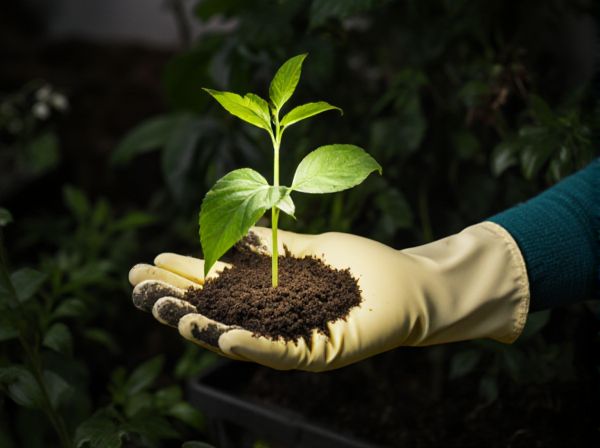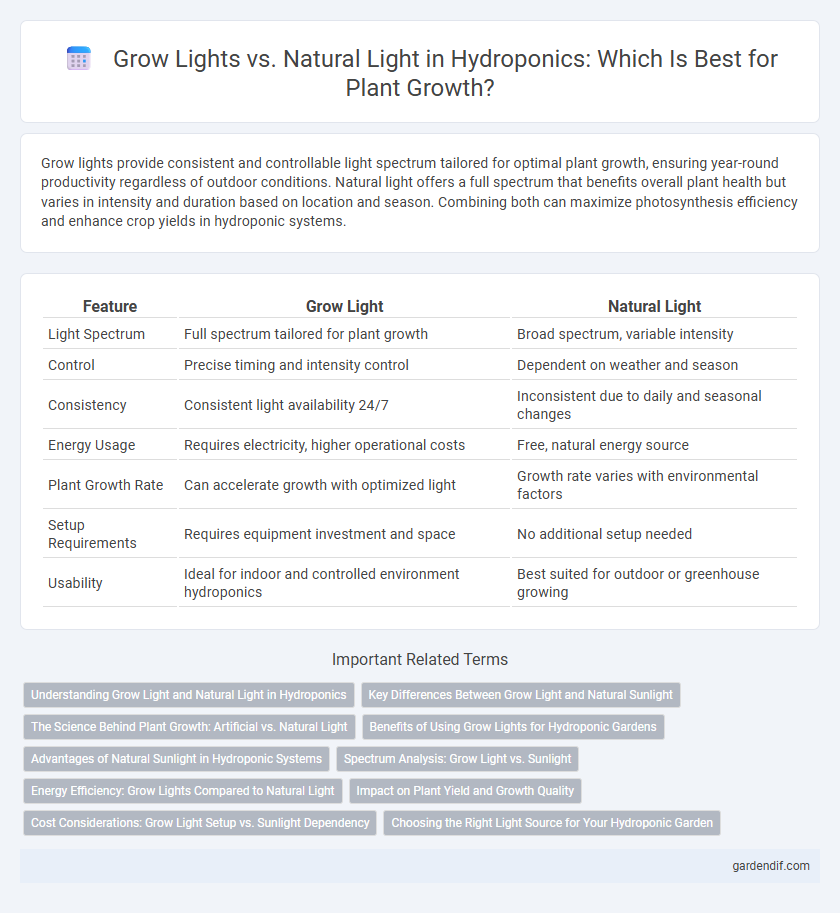
Grow Light vs Natural Light Illustration
Grow lights provide consistent and controllable light spectrum tailored for optimal plant growth, ensuring year-round productivity regardless of outdoor conditions. Natural light offers a full spectrum that benefits overall plant health but varies in intensity and duration based on location and season. Combining both can maximize photosynthesis efficiency and enhance crop yields in hydroponic systems.
Table of Comparison
| Feature | Grow Light | Natural Light |
|---|---|---|
| Light Spectrum | Full spectrum tailored for plant growth | Broad spectrum, variable intensity |
| Control | Precise timing and intensity control | Dependent on weather and season |
| Consistency | Consistent light availability 24/7 | Inconsistent due to daily and seasonal changes |
| Energy Usage | Requires electricity, higher operational costs | Free, natural energy source |
| Plant Growth Rate | Can accelerate growth with optimized light | Growth rate varies with environmental factors |
| Setup Requirements | Requires equipment investment and space | No additional setup needed |
| Usability | Ideal for indoor and controlled environment hydroponics | Best suited for outdoor or greenhouse growing |
Understanding Grow Light and Natural Light in Hydroponics
Grow lights in hydroponics provide a controlled spectrum of light tailored to enhance plant growth, regardless of environmental conditions, delivering consistent intensity and duration crucial for photosynthesis. Natural light varies in intensity and duration depending on geographic location and weather, which can limit plant development or increase variability in growth cycles. Optimizing hydroponic systems often involves integrating grow lights to supplement or replace natural light, ensuring a stable and efficient light source that maximizes crop yield and quality.
Key Differences Between Grow Light and Natural Sunlight
Grow light systems provide consistent light spectra specifically designed for photosynthesis, while natural sunlight varies in intensity and spectral composition throughout the day. Unlike natural sunlight, grow lights allow precise control over photoperiods and light wavelengths, optimizing plant growth cycles and energy efficiency. However, natural sunlight delivers a full spectrum of light including UV and infrared, which can enhance plant development and nutrient synthesis beyond artificial lighting capabilities.
The Science Behind Plant Growth: Artificial vs. Natural Light
Artificial grow lights provide specific wavelengths of light tailored to optimize photosynthesis, often enhancing plant growth efficiency compared to natural sunlight, which delivers a broad spectrum but variable intensity depending on weather and time. Photosynthetically active radiation (PAR) from grow lights can be controlled to ensure consistent light exposure, directly influencing chlorophyll production and energy conversion in hydroponic plants. Research shows that plants under full-spectrum LED grow lights often exhibit faster growth rates and higher yields in controlled environments than those reliant solely on natural light.
Benefits of Using Grow Lights for Hydroponic Gardens
Grow lights provide consistent and controllable light intensity tailored to the specific spectrum requirements of hydroponic plants, maximizing photosynthesis and growth rates. They enable year-round cultivation regardless of external weather conditions, ensuring stable yields and faster crop cycles. Optimizing light duration and quality with grow lights reduces plant stress and enhances nutrient absorption in hydroponic systems compared to reliance on natural sunlight alone.
Advantages of Natural Sunlight in Hydroponic Systems
Natural sunlight offers a full spectrum of light essential for optimal photosynthesis, enhancing plant growth and nutrient absorption in hydroponic systems. It provides a cost-effective and sustainable light source, eliminating the need for electrical energy consumption associated with artificial grow lights. Exposure to natural sunlight also promotes healthier plant development by reducing stress and improving resistance to diseases and pests.
Spectrum Analysis: Grow Light vs. Sunlight
Grow lights offer a tailored spectrum of light that closely matches the photosynthetically active radiation (PAR) range, optimizing plant growth by providing specific wavelengths like blue and red light that enhance photosynthesis and flowering. Natural sunlight provides a full spectrum of light, including ultraviolet and infrared rays, which benefits plant health but varies by time of day and weather conditions. Spectrum analysis reveals that grow lights can deliver consistent, customizable light intensity and quality, while sunlight offers broader spectral diversity essential for some plant processes.
Energy Efficiency: Grow Lights Compared to Natural Light
Grow lights offer precise control over light spectrum and duration, enabling optimized energy use compared to the variable intensity of natural light. Energy-efficient LED grow lights consume significantly less power while maximizing photosynthesis, reducing overall electricity costs for hydroponic systems. Unlike natural light, grow lights provide consistent illumination regardless of weather or season, enhancing plant growth efficiency year-round.
Impact on Plant Yield and Growth Quality
Grow lights provide consistent and controllable light spectra, enhancing photosynthesis efficiency and significantly increasing plant yield compared to variable natural light conditions. The precise spectrum and duration offered by LED and fluorescent grow lights promote faster growth rates and improved nutrient absorption, resulting in higher quality crops. Natural light variability can limit growth consistency but benefits plants with full-spectrum exposure that supports robust development and natural metabolic processes.
Cost Considerations: Grow Light Setup vs. Sunlight Dependency
Grow light setups involve upfront costs for equipment such as LED or fluorescent bulbs, fixtures, and electricity expenses, which can amount to a significant long-term investment. In contrast, natural sunlight is free but depends on geographic location, weather conditions, and seasonal changes that can affect crop yield consistency. Hydroponic growers must balance energy consumption and initial setup expenses against the variability and unpredictability of sunlight exposure to optimize cost-efficiency.
Choosing the Right Light Source for Your Hydroponic Garden
Choosing the right light source for your hydroponic garden depends on plant type, growth stage, and available space. Grow lights, such as LED or fluorescent, offer controlled spectrum and intensity, enabling consistent growth regardless of outdoor conditions. Natural light provides full-spectrum benefits but varies seasonally and may require supplemental lighting to ensure optimal photosynthesis and yield.
Grow Light vs Natural Light Infographic

 gardendif.com
gardendif.com